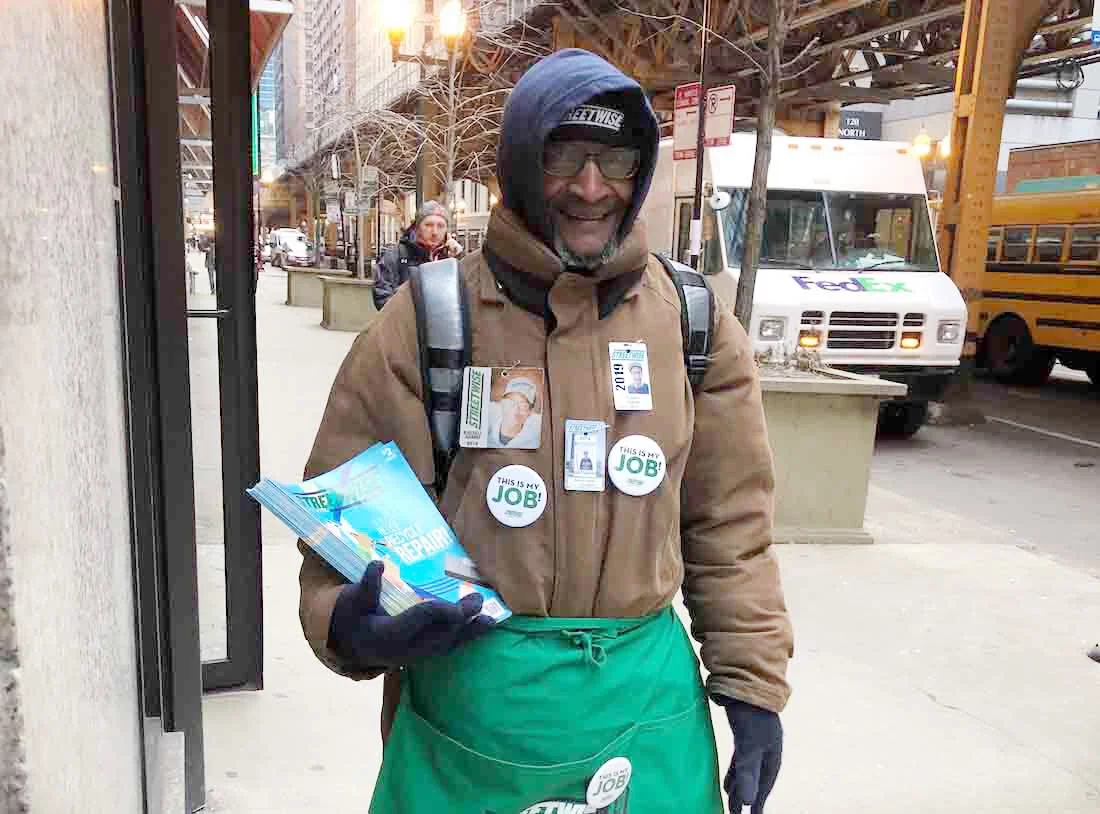Streetwise: The Magazine that Pays to Sell
Published at Medill Reports
Russell Adams wears a salt and pepper patchwork beard, spirited brown eyes and a crescent moon half smile as he waves to passersby outside a CVS on the corner of Washington and Wells. Bundled in a fuzzy plaid hood and camel brown coat, he clutches the stack of magazines close to his chest, not approaching anyone, just waiting patiently.
People stream by keeping their eyes to the ground as they wait for the white “WALK” man to allow their crossing. They apparently don’t notice the white button on Adams’ coat that reads, “This is my JOB!”, or the employment identification badge pinned to its left, or at least, they pretend not to.
Adams is a StreetWise vendor—one of over 150 active vendors in Chicago who sell the weekly magazine designed to help homeless people re-enter the workforce. Since its founding in 1992, StreetWise has peppered the streets of Chicago, providing more than 12,000 men and women with “a hand up—not a handout,” according to its 2017 annual report.
Following StreetWise’s launch, the idea of an entrepreneurial street paper spread to London, and then more cities followed suit with their own versions. Today, over 100 independently-operated magazines and street papers exist and collaborate through the International Network of Street Papers, founded in 1994.
The business model of this entrepreneurial magazine is fairly simple. The vendors pay $0.90 per copy and sell them for $2.00, keeping the remaining $1.10 as income. Adams says he sells about 30 magazines each day, but it fluctuates. “Our model allows vendors to give back and be an active part of society,” says StreetWise publisher and creative director Dave Hamilton. “They are not asking for free money or shaking a cup. I think most of us would prefer to support someone who is trying to change their life for the better.”
It’s no secret that print media has experienced a sharp decline in the digital age. StreetWise has mirrored this shift, showing smaller sales figures today than in 1992. However, as Hamilton will tell you, “One thing that keeps StreetWise relevant is the philanthropy angle; our customers know that they are directly impacting that person’s life upon purchase.” He says thousands have been helped through this organization, but didn’t know the exact number.
A train revs by, sending whirrs and clinks into the icy air. Adams shivers. “My experience was kind of hard at first.”
Adams grew up on the South and West Sides of Chicago. He remembers selling the Sun-Times when he was a little boy, a nod to his salesman experience, he jokes. He received limited schooling before joining the workforce. Adams was laid off from his first job, and remained unemployed for several months before finding another job at a printing company in the late ‘80s. He worked there for about 15 years, before being laid off again for lack of technical skills in the early 2000s, he recounts.
After that Adams slipped into a state of apathy. “I just didn’t care anymore,” he recalls. “I didn’t have money, I didn’t have a job or income, so I couldn’t pay my rent.” He began abusing alcohol and drugs, and set up camp on Lower Wacker, joining Chicago’s growing homeless population, estimated to be around 6,700 at the time, according to The Homeless Point-in-Time Count and Survey Report. The survey pegs the current population to be about 5,450 people, living in shelters or on the street.
“One day I got tired of it,” Adams says. “So, I went to StreetWise in 2004, and they started me off with 10 magazines—you get three free. I had to sell the 10 magazines and then I could buy me some more. I used my knowledge and my determination to make it. And here I am, 15 years later doing the same thing.” Between vending and his part-time custodial job at StreetWise, Adams works roughly 11 hours a day, 5 days per week. He says a check comes every two weeks and his income “works out fine” to cover the bills.
A woman walks out of the CVS and hands Adams a few dollars, smiling and wishing him well. He walks over to give some of his extra magazines to another vendor who ran out. “It can be hard at times with the cold weather, but you gotta pay the bills, so after a few years you get used to it.”
He opens up the magazine of the week: the vendor issue, a best seller that highlights the vendors’ stories. “Look! I’m right here.” He flips to page six and points to his picture on the vendors’ Super Bowl predictions. Adams weighed the pros and cons of each team, but settled on an inevitable Patriots victory.
Another woman passes, and Adams nods, greeting her. “She had a loss in the family recently, nice lady,” he mentions.
Per reader surveys, Editor in Chief Suzanne Hanney estimates that readership centers on mostly white, well-educated, highly paid people with influential jobs, ages 35 to 55, and slightly more women than men. As Hanney phrases it, “Affluent enough to be altruistic.”
This perceived reader base drives story material for StreetWise, which covers issues that impact the very vendors who sell the magazine, such as environmental education, gentrification and social policy. Recent stories have covered the Poor People’s Campaign, low-cost restaurant recommendations and repairing items for recycling initiatives. Hanney writes some content for the magazine, but interns, writers and vendors contribute on a volunteer basis. Compensated freelancers are occasionally brought in for longer in-depth stories. The writing style is not flashy, and tells each story in a straightforward and accessible manner.
The 16-page magazine was originally a newsprint paper, but the organization thought consumers would appreciate the look of a print magazine, so the publication received a makeover in 2008. The board of directors is made up of prominent community members such as Aaron Friedman with Walgreens Boot Alliance and 7th District U.S. Congressman Danny Davis.
The StreetWise office sits at 4554 N. Broadway, and acts as an additional resource for its vendors, providing free meals in the café, social services and the StreetWise Transitional Employment Program (STEP) to help hone in on the various skills needed to join the workforce.
Hamilton acknowledges that StreetWise is still practicing the art of self-improvement. “Advertisements …is something we need to get better at.” At its birth, the Chicago-based organization had a dedicated advertising department, but has suffered many of the same problems that large print consumer magazines are dealing with. “We don’t have the staff to seek it out, so most of our advertisers come to us when they need to. Two of our consistent advertisers have been Steppenwolf Theater and fellow non-profit, Chicago Shares.”
Advertising aside, the publication sells approximately 20,800 copies per month. Events such as their annual gala, coat drive and pop up shop add to their revenue stream. Other revenues come from fundraising, magazine social enterprise and program revenue—in the form of grants when someone is placed in a job through STEP.
Hamilton thinks one of their biggest challenges is messaging. “I don’t believe that most of Chicago understands our business model, and how we are effectively helping Chicago’s poor become entrepreneurs. I want more Chicagoans to understand that vendors work for themselves. But because of how society brushes aside the homeless, people sometimes consider StreetWise vendors to be a nuisance, like a panhandler, and won’t take the time to learn that this is a person who is trying to change their life. We have been around for 27 years, and this model is tried and true, here and internationally, but somewhere along the way we haven’t been sharing our message correctly with newer generations.”
Streetwise vendors take many forms. A majority are homeless, but nearly as many are living in unstable housing, subsidized housing or renting. Roughly 75 percent are African American males between the ages of 45 and 65. Some are veterans, and about half have a disability. “We accept anyone who comes in,” says Hanney. “Many of our vendors have been homeless, but just as many are at risk.”
Back at Washington and Wells, more than one man stops, calling Adams by name or “Brother,” fist-bumping and greeting him with familiarity. He’s nine years sober and says it feels nice. He’s a father and grandfather. He lives in an apartment on the West Side with his girlfriend of over 30 years, still keeping an eye out for decent work opportunities.
Sometimes Adams stops to give a few dollars to panhandlers because he’s been there, and “we’re all trying to live and make a living.” As dusk settles, he stands humbly proud on his corner, 60 years young, selling his stack of magazines, smile creeping up on his honey and mocha skin, weathered like a lucky penny.






